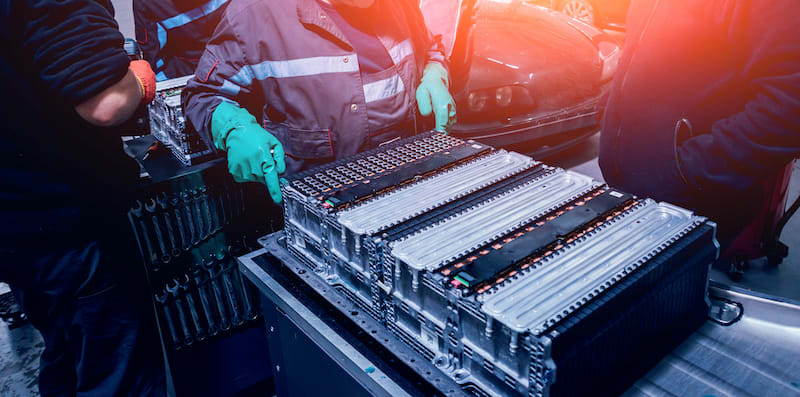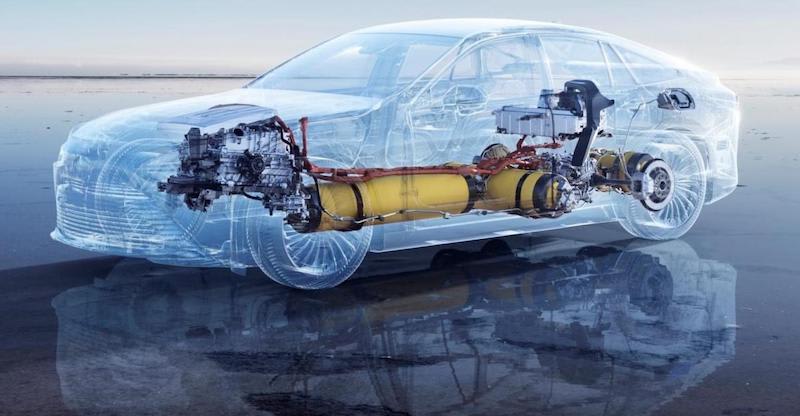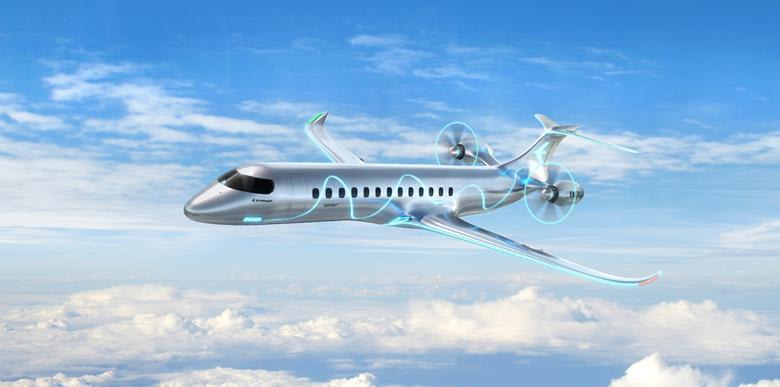Is Hydrogen the Future of Transport?
Follow articleHow do you feel about this article? Help us to provide better content for you.
Thank you! Your feedback has been received.
There was a problem submitting your feedback, please try again later.
What do you think of this article?
Electric vehicles are growing in popularity as manufacturers and governments around the world make commitments that will end the dominance of fossil fuel-powered vehicles. Will we, as consumers, embrace electric vehicles?
The problem for many of us is that oil is just too convenient. Petrol and diesel are such useful fuels for vehicles because they provide a high energy density. They can deliver a lot of energy from a relatively small volume and weight. A modern family car might carry around 60 litres of fuel at a mass of just less than 45 kilograms. This will be sufficient to take the car nearly 1000 kilometres. When the time comes to fill the tank, it will take less than 10 minutes at any of the thousands of service stations on our roads.
The Limitations of Electric Vehicles
If we compare this to an equivalent electric car, the battery is several times the mass of a 60-litre fuel tank, and it will struggle to provide the same range. The manufacturers of today’s highest-performing electric vehicles are suggesting that they can reach just 500 kilometres. Charging time is also a factor. Some of the manufacturers are creating networks of dedicated charging stations, capable of providing an electric car with 300 kilometres’ worth of power in just 15 minutes. For most of us, charging the same vehicle from a domestic outlet will take hours.
There are two solutions to this problem. The first is continued research in battery technology to improve both capacity and charging time. The second is for manufacturers to make rapid charging commonplace by creating infrastructure rivalling that of conventional petrol. Whether they exist side-by-side remains to be seen – the engineering geek in me recoils in horror at the idea of high-voltage DC charging stations on the same site as pumps that provide petrol. Nevertheless, if this network can be created then the loss of convenience will be overcome. I think that most drivers would regard a 15- to 20-minute break every 300 kilometres to be perfectly acceptable.
Electric Vehicle Batteries
Even once these consumer issues have been resolved, do electric vehicles provide the solution that will help reduce climate change? Electric vehicles must be recharged, and this energy needs to be created somehow. It would be nice to believe that all energy created for electric vehicles comes from renewable sources. Sadly, that is not the case and is unlikely to change for some time. Our dependence on the fossil fuel industry has not yet been broken.
Sourcing Lithium for Batteries
There are also other environmental impacts. The most common technology used for electric vehicles is the lithium-ion battery. Lithium is obtained using several methods and, until recently, these have been environmentally costly in terms of the energy, land and water consumed in the process. It is important that we consider this. The World Bank has predicted that we need to extract 5 times more lithium than we do today to meet the future demand for batteries.
Batteries also have a limited lifespan. As cars that carry them are scrapped, batteries will need to be removed. The good news is that large parts of these batteries can be recycled, but this will also consume energy. Are we solving a problem today by pushing a different problem 7 to 10 years into the future? Having asked that question, if lithium can truly be recycled from old batteries, perhaps this will reduce our need for extracted lithium in the future. In addition, there are new sources that can be exploited in the form of deep geothermal waters which hold very high levels of lithium. Extracting this water would appear to be a more ecologically sound method of obtaining lithium.
Perhaps batteries are the future after all. But there is another solution being suggested in the form of hydrogen. Hydrogen is one of the most common elements in the universe. It represents nearly three-quarters of the mass of our sun and is the fuel that creates its heat and light.
Hydrogen Fuel Cells
Hydrogen is useful because it forms the key component of hydrogen fuel cells. The easiest way to describe a hydrogen fuel cell is a never-ending battery. As long as the fuel cell is provided with a flow of hydrogen and oxygen, it will create electricity. It does this without combustion, and the by-product is water. A hydrogen-fuelled car does not need to be recharged. Instead, its fuel tank would be refilled conventionally, in the same way as petrol vehicles.
Toyota's vision of hydrogen cars - the new Mirai
Hydrogen does bring with it a unique set of problems. First, it is incredibly light, and in its gaseous form will simply rise in the atmosphere. It is also highly flammable and free hydrogen released into the atmosphere will react with oxygen under the right conditions. The reaction makes pure water but this only occurs after an energetic and rather inconvenient explosion.
Finally, finding hydrogen takes effort. Due to its natural tendency to combine with other chemicals, it is not found in its gaseous state. The most common method of production relies on the burning of – you’ve guessed it – fossil fuels. It can also be created by electrolysis, an experiment that many of us will remember from high school. However, this method is even more inefficient than normal production, and so fossil fuels remain the primary source.
For hydrogen fuel cells to become a common solution for road vehicles will require a whole new infrastructure to be developed. The tendency of hydrogen to explode is of concern, and the facilities for transporting and storing hydrogen will need a new approach. Unlike petrol which can be held at normal atmospheric pressure, hydrogen fuel will be supplied as a compressed gas. These tanks that contain hydrogen will need to be spherical to withstand the pressure inside, and any engineer will tell you how a large ball is an inconvenient shape when building something like a car.
So, hydrogen is difficult to get hold of, difficult to hold on to and stands a small chance of going bang if it gets out. For an entertaining but highly accurate study on the problems of creating and storing hydrogen, I can recommend The Martian by Andy Weir.
If it’s going to be so difficult, why go to all this effort?
As before, the answer is energy density. For a given mass of hydrogen, the fuel cell will provide a greater range than an equivalent lithium-ion battery. Despite the superior range, the inconvenience of hydrogen might prevent its widespread adoption for road travel. But there is an arena that might embrace hydrogen as a solution.
Hydrogen in Aviation
The aviation industry has long been under scrutiny for its effect on climate change. Despite the advances in modern aero-engine design, flying an aeroplane burns a huge amount of fuel. However, due to the long distances involved, current battery technology cannot provide the capacity to deliver the performance that the airlines need. In the world of aviation, weight is the enemy, and there comes a point where adding more batteries to an aircraft degrades its effectiveness and stops it from being a viable way of transporting anything.
Hydrogen fuel cells, with their higher energy density, might be a great hope for commercial aviation. The problems of transporting and storing hydrogen will be far more manageable for the aviation industry. There is no need for a filling station every 50 kilometres as there is in road transport, and the major airports are large enough to support the infrastructure needed. There are also far fewer of them.
The industry is starting to look at hydrogen as the fuel of the future. Brazilian aircraft manufacturer Embraer has released an impression of its newest aircraft, and it really appeals to the airhead in me.
Image: Embraer
The new E50-H2GT is replacing conventional turbofan engines with a jet fan – the blades are on the outside of the engine, not the inside. What is more, the engines are placed at the rear of the fuselage rather than under the wing. This was a common arrangement in the early days of jet aircraft but has fallen out of favour more recently. However, there is strong reasoning behind this return to the old ways.
Embraer has designed this aircraft to be ready for hydrogen fuel. As the hydrogen will need to be stored in a spherical tank, there is no room for it in the wings. Instead, the tank will be at the rear of the fuselage, so why not place the engines next to where the fuel is stored? This may seem like an obscure design feature, but I think it is exciting to see how manufacturers are looking to the future.
The Future of Hydrogen
Does hydrogen represent the future, or is it just one piece in the jigsaw puzzle that represents our future energy needs? I believe that both batteries and hydrogen have their strengths, and so the answer is that each will find its place in the energy network.
While neither solution yet promises independence from fossil fuels, they do provide practical solutions to the problems of transportation. Alongside further developments in energy production – solar, wind, even space-based power – they will help us to achieve the climate change commitments that have been made on our behalf.





Comments